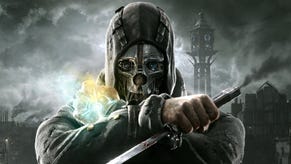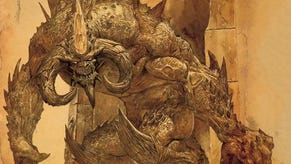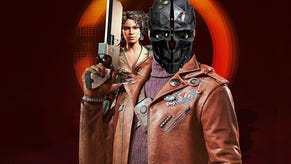Year Of The Rat: Dishonored Preview
A dark project
Arkane co-founder Raf Colantonio is playing his new game all wrong. This is the first time I’ve had a first-hand look at Dishonored, the immersive sim from folk who’ve worked on the likes of Deus Ex, Half-Life 2 and Dark Messiah: Might & Magic, but I can tell you, right now, that one of its creators is playing it wrong. At least, that’s what my brain’s screaming at me. And I, too, am wrong.
Colantonio is playing Dishonored for a convention crowd, 20 compressed minutes imbued with maximum flash to ensnare the attention of exhausted and jaded hacks who’ve been shown game after game and are already thinking of their next appointment. It's also, of course, for watchers and commentors for whom Calls of Duty and Gearses of War are their bread and butter: they wouldn't pay attention to a stealth game, so the sound and fury of all-out action must be there too. So he’s playing it with bloodshed and drama, with stabbings and desperate escapes amidst a hail of gunfire. He’s playing it wrong, whispers that dumb brain of mine – he could have hidden there, climbed that, pickpocketed rather than killed and looted that guard… It’s all wrong, not at all what I’d do.
Oddly, this only makes me lean closer, my excitement grow. I’m not being shown the game as I would approach it, but Colantonio is carefully to hint at how that would be done, to sneak in sneaking alongside the killing. So I extrapolate and deduce, plot and wonder. The sense of possibility, of mind-mapping what I might have done, is that much richer than actually watching a guy hide behind walls and wait for guards’ backs to turn would ever be. With all the powers, all the openness, all the aesthetic strangeness on show here - well, the thought of how I might go at it once I have the chance to instantly makes Dishonored the most promising and exciting thing I saw at Gamescom by a country mile.
Here, Colantonio has left a trail of destruction and death – the most efficacious route for the time available, yet even so he was constantly making choices – which door, which street, which roof, which crowd-control power, which moments to cut and run, which times require head-on assault. He's shown a little bit of everything, and how ad-hoc, adaptive thinking can pull the player out of all kinds of messes, but the need to impress means it's not been the methodical, laser-focused path that a player of Thief or Deus Ex might have taken. So: what would I have done?
Used more rats, probably. Rats have forever been gaming’s whipping boys: usually you’re killing ten of them in a cellar in the hope of experience points and magic boots, and in a best case scenario they’re just ambient creatures to optionally waste bullets on. In Dishonored, appropriately and not coincidentally a game about cities and plagues, perhaps the archetypical videogame enemy (after zombies and Nazis) pushes front and centre at last, becoming alternately enemy, assistant and lead character.
Packs of them, a living swarm of matted fur and skittering claws, lurk in Dishonored’s dark and dank places. Should they scent blood, the larger groups are likely descend upon the injured as a squirming, ravenous mass – one human foe’s flesh is stripped, horrifyingly, from his bones within moments when the rats find their way to him, even as his startled comrades watch. Light, however, will keep the beasts at bay. For Dishonored’s star, former imperial bodyguard and now wanted assassin Corvo, this presents a dilemma. Notionally a man of stealth, darkness should be his friend, his greatest ally. The rats mean it can also be his deadliest enemy.
Yet the rats themselves can help as much as hinder Corvo. They can distract or even kill the city guards who hunt him, and they can be his vessel. Corvo is able to call upon supernatural forces to aid his quest to exonerate himself from the murder of the Empress he once served. He is able to freeze time, thus making his way unseen past foes or dispatching them without threat. He is capable of 'blinking' across short distances, effectively able to teleport to a rooftop he can’t quite jump to or to safe cover he’d be seen running to. Or he can seize control of a rat.
There’s hardly a creature alive more built for stealth: fast, tiny, yet something most humans would try to avoid. In the playthrough I’m shown, only the most prescribed possibilities are demonstrated: grates through which the puppeted vermin can find its way into a building housing Corvo’s target. When I play – when I play Dishonored the right way – the city will be mine to explore on four minute feet. Not for me the coward’s route of the obvious hidden entrance, but instead the constant pursuit of places I shouldn’t go – but can, somehow. When I talk to another of Dishonored’s creators, former Ion Storm designer Harvey Smith, a little later, he mentions a tester who discovered he could place a mine on a rat’s back, possess the creature, walk it to a pack of enemies, leap out of the beast and then await carnage. I’ll have that interview up soon, with more such details, but it seems to key to see Dishonored as a game of many variables. It’s up to you to combine them and see what happens. It could be disastrous. It could be beautiful.
Smith also mentions the as-yet unseen possibility of possessing fish. As a means of both silent incursion and dramatic escape, this is perhaps even more tantalising than getting my rat on. The possession mechanic seems to roam far beyond mere psychic inhabitation, with Corvo himself able to appear where the dominated animal is – so truly able to steer himself invisibly indoors, not simply scout the lie of the land. The rats are not immune from discovery or harm, however – make yourself known to a human while in rodent form and you can expect to find yourself on the wrong end of a stamping boot.
The downside to being a rat is that it means you have only a small, fisheye-perspective, semi-monochromatic view of what it is a visually remarkable world. Much has been made of the architect of Half-Life 2’s City 17, Viktor Antonov, designing Dishonored’s alternate-history metropolis, Dunwall. It’s true that it’s hard not to see City 17 and the Combine in the tortured angles of Dunwall’s metal elements, the light-walls that cordon off areas, the mounted speakers echoing messages of paranoia and oppression and the armoured, mechanical, undeniably Strider-like stilt-vehicles that patrol its larger streets.
Yet this is just an element, a layer on top of many. Dunwall itself is more like Victorian London, proud and beautiful, but dirty and ruined – grand and regal buildings offset by nearby grime and snarling graffiti (“she was a whore!”). On top of that goes an air of haunting, unspoken menace: mounted, frenzied-looking animal heads seem to be the nobility’s interior decorations of choice; the victims of Dunwall’s devastating plague can be found bound in bloody shrouds within boarded-up buildings; the streets feature random acts of violence by thugs upon innocents which Corvo can interrupt if he stumbles across one; Corvo’s own killings, if he chooses the consequence-heavy path of Chaos rather than avoidance, are extremely brutal, almost disgusting to behold. On top of that goes the aforementioned, brutalist sci-fi trappings such as lightwalls and armoured stilt-vehicles piloted by state-serving guards, on top of that goes Corvo’s fantastical powers… and on top of that… On top of that go the whales.
The industrial revolution didn’t happen in Dishonored’s world. But something else did. Something that isn’t good news for whales. As Corvo steals across a rooftop, he looks to Dunwall’s bounding harbour. A giant tanker slopes its way past, vast arms on top of it transporting an enormous, imprisoned whale. The sight is tragic, horrifying, surreal, impossible to ignore. For the people of Dunwall, all it signals is a fuel shipment.
Whale oil is the source of and key to this world’s industry. When Corvo seeks a way to disrupt a light gate blocking one possible path to his target, he follows its cabling to its control panel. Later, he’ll have acquired the blueprints that allow him to hack it and gain access himself, but for now a noisier alternative is to simply remove its whale-oil battery. This is a city of amazing accomplishments – but clearly the path taken to them has been a dark one. Combined, the many visual and thematic layers in Dishonored make for a magnetic, magnificent sight: wild and unsettling, colourful yet downcast, explicable but mysterious. I want to see so much more of it.
In the demo I watch, Corvo combines an ad-hoc mix of roofs, doors, tunnels, rats, running, hiding, imbibing strange liquids, spells, spell-unlocking and brazen violence to create a custom route to his target, presumed corrupt lawyer Arnold Timish. His assassination is neither noble or silent. Instead, Corvo goes in guns and knives out, using windblast to scatter Timish and his bodyguards across the room, then freezing and bloodily stabbing or headshotting them without hesitation. This does not go unnoticed by Dunwall's guards, so Corvo flees desperately – plunging out of a window then blinking spectacularly from roof to roof, darting above and behind the huge iron watch towers that spray bullets at him as clanging bells sound damningly all around and, deftly, circling around the looming, flame-spraying stilt-walkers that block his egress. From the front, they are towering, faceless machines, surely impervious to any of Corvo's weapons. From behind, it’s a guy standing in the cockpit of long-limbed vehicle, his all too human back exposed as he tugs on levers to steer the construct about. A back that might as well have a target painted on it. So down he goes, and to safety Corvo goes. A frail, shadowbound weakling Corvo is not. Dunwall is his to master.
He did it all wrong, of course. I’d have gotten in and out, silently. No-one who didn’t have to die would have died. Rodent feet would have explored every street. No-one would known I was ever there. But I can appreciate that Corvo is not Garrett, not if he doesn't want to be. Corvo is something else: he is Altair, he is Adam Jensen, he is Subject Delta. He is Corvo. With all these powers, all these choices, all these routes available to him, perhaps he wouldn’t want to tread the least flashy, most nondescript, invisible path after all. Who could blame him?















